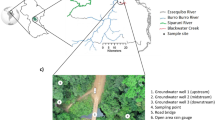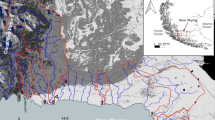Abstract
Extreme climatic events may be translated into a higher frequency of both dry and wet years. Frequent droughts pose a challenge to water supply in terms of both quantity and quality. In order to cope with this, there has to be a documentation on the concentration of chemicals in water during such events. The southeast region of Brazil experienced a major drought event in 2014 leading to number of social, economic, and environmental impacts. The objective of the present paper is to understand the effect of an extreme drought on dissolved organic and inorganic carbon concentrations of the Piracicabal river, which is under high human pressure. Concentrations of both dissolved organic (DOC) and inorganic carbon (DIC) were monitored daily, for 30 days, during a dry month in 2014. DOC values found here were at least twice those observed in the river in non-extreme conditions. Rain events within this drought led to significant differences in discharge, DOC, and DIC. We built a dilution-concentration model which described an exponential relationship between discharge and both carbon forms. This indicated that drastic changes in concentrations of DOC and DIC are expected during such events. Our results may also apply to a number of regions in the world especially those of the developing countries where rivers are highly subjected to sewage impact.




Similar content being viewed by others
References
ANA (Agência Nacional de Águas) (2015). Dados de referência acerca da outorga do sistema Cantareira. http://arquivos.ana.gov.br/institucional/sof/Renovacao_Outorga/DDR_Sistema_Cantareira%20-%2012Jun15%20-%20FINAL.pdf. Accessed 23 May 2020.
ANA (Agência Nacional de Águas) (2018). Repartição das vazões transpostas da bacia hidrográfica do rio Piracicaba para a bacia hidrográfica do Alto Tietê pelo Sistema Cantareira para fins de cobrança pelo uso de recursos hídricos. https://www.ana.gov.br/todos-os-documentos-do-portal/documentos-sas/arquivos-cobranca/00000-016998-2018_nota_tecnica_conjunta_1_2018__daee_sas_rateio-de-vazoes-cantareira.pdf. Accessed 08 June 2020.
Andrade, T. M. B., Camargo, P. B., Silva, D. M. L., Piccolo, M. C., Vieira, A. S., Alves, L. A. F., Joly, C. A., & Martinelli, L. A. (2011). Dynamics of dissolved forms of carbon and inorganic nitrogen in small watersheds of Coastal Atlantic Forest in Southeast Brazil. Water Air Soil Pollut, 214, 393–408.
Ault, T. R. (2020). On the Essentials of drought in a changing climate. Science, 368, 256–260.
Ballester, M. V. R., Martinelli, L. A., Krusche, A. V., Victoria, R. L., Bernardes, M., & Camargo, P. B. (1999). Effects of increasing organic matter loading on the dissolved O2, free dissolved CO2 and respiration rates in the Piracicaba river basin, southeast Brazil. Water Res, 33, 2119–2129.
Billerbeck, C., & Mello Junior, A. V. (2018). Optimal operation of the Cantareira System for a critical inflow period. Eng Sanit e Ambient, 23(6), 1121–1130.
COBRAPE (COMPANHIA BRASILEIRA DE PROJETOS E EMPREENDIMENTOS) (2011). Plano das bacias hidrográficas dos rios Piracicaba, Capivari e Jundiaí 2010 a 2020. Relatório final.
Daniel, M. H. B., Montebelo, A. A., Bernardes, M. C., Ometto, J. P. H. B., Camargo, P. B., Krusche, A. V., Ballester, M. V. R., Victoria, R. L., & Martinelli, L. A. (2002). Effects of urban sewage on dissolved oxygen, dissolved inorganic and organic carbon, and electrical conductivity of small streams along a gradient of urbanization in the Piracicaba River Basin. Water Air Soil Pollut, 136, 189–206.
Dobrovolski, R., & Rattis, L. (2015). Water collapse in Brazil: the danger of relying on what you neglect. Natureza & Conservação, 13, 80–83.
Fan, J. L., Liang, Q. M., Liang, X. J., Tatano, H., Kajitani, Y., & Wei, Y. M. (2014). National vulnerability to extreme climatic events: the cases of electricity disruption in China and Japan. Nat Hazards, 71(3), 1937–1956.
Frederice, A., & Brandão, J. L. B. (2016). Efeito do. Sistema Cantareira sobre o regime de vazões na bacia do rio Piracicaba. Revista Brasileira de Recursos Hídricos, 21(4), 797–810.
Groppo, J. D., Moraes, J. M., Beduschi, C. E., & Martinelli, L. A. (2008). Trend analysis of water quality in some rivers with different degrees of development within the Sao Paulo State, Brazil. Rivers Research and Applications, 24(8), 1056–1067. https://doi.org/10.1002/rra.1091.
Hammer, O., Harper, D. A. T., & Ryan, P. D. (2001). PAST: Paleontological Statistics Software Package for education and data analysis. Palaeontol Electronica, 4(1), 1–9.
Harrison, M. T., Cullen, B. R., & Rawnsley, R. P. (2016). Modelling the sensitivity of agricultural systems to climate change and extreme climatic events. Agric Syst, 148, 135–148.
IBGE (Instituto Brasileiro de Geografia e Estatística) (2011). CENSO DEMOGRÁFICO 2010: características da população e dos domicílios: resultados do universo. http://www.sidra.ibge.gov.br/cd/cd2010universo.asp?o=5&i=P. Acessed 23 May 2020.
Kaushal, S. S., Gold, A. J., Bernal, S., & Tank, J. L. (2018). Diverse water quality responses to extreme climate events: an introduction. Biogeochemistry, 141, 273–279.
Khan, S. J., Deere, D., FDL, L., Humpage, A., Jenkins, M., & Cunliffe, D. (2015). Extreme weather events: should drinking water quality management systems adapt to changing risk profiles? Water Res, 85(15), 124–136.
Krusche, A. V., Carvalho, F. P., Moraes, J. M., Camargo, P. B., Ballester, M. V. R., Hornink, S., Martinelli, L. A., & Victoria, R. L. (1997). Spatial and temporal water quality variability in the Piracicaba River Basin, Brazil. J Am Water Resour Assoc, 33, 1117–1123.
Krusche, A. V., Martinelli, L. A., Victoria, R. L., Bernardes, M., Camargo, P. B., Ballester, M. V., & Trumbore, S. E. (2002). Composition of particulate and dissolved organic matter in a disturbed watershed of southeast Brazil (Piracicaba River Basin). Water Res, 36, 2743–2752.
Lombardo, L., Cama, M., Marker, M., & Rotigliano, E. (2014). A test of transferability for landslides susceptibility models under extreme climatic events: application to the Messina 2009 disaster. Nat Hazards, 74(3), 1951–1989.
Martinelli, L. A., Krusche, A. V., Victoria, R. L., Camargo, P. B., Bernardes, M., Ferraz, E. S., Moraes, J. M., & Ballester, M. V. R. (1999). Effects of sewage on the chemical composition of Piracicaba River, Brazil. Water Air Soil Pollut, 110, 67–79.
Martinelli, L. A., Coletta, L. D., Ravagnani, E. C., Camargo, P. B., Ometto, J. P. H. B., Filoso, S., & Victoria, R. L. (2010). Dissolved nitrogen in rivers: comparing pristine and impacted regions of Brazil. Brazilian Journal of Biology, 70(3), 709–722. https://doi.org/10.1590/S1519-69842010000400003.
Mastrandrea, M. D., Tebaldi, C., Snyder, C. W., & Schneider, S. H. (2011). Current and future impacts of extreme events in California. Clim Change, 109, 43–70.
Moraes, J. M., Pellegrino, G. Q., Ballester, M. V., Martinelli, L. A., Victoria, R. L., & Krusche, A. V. (1998). Trends in hydrological parameters of a southern Brazilian watershed and its relation to human induced changes. Water Resour Manag, 12, 295–311.
Nienie, A. B., Sivalingam, P., Laffite, A., Ngelinkoto, P., Otamonga, J. P., Matand, A., Mulaji, C. K., Mubedi, J. I., Mpiana, P. T., & Poté, J. (2017). Seasonal variability of water quality by physicochemical indexes and traceable metals in suburban area in Kikwit, Democratic Republico of Congo. Int Soil Water Conserv Res, 5, 158–165.
Rivas, M. L., Spínola, M., Arrieta, H., & Faife‐Cabrera, M. (2018). Effect of extreme climatic events resulting in prolonged precipitation on the reproductive output of sea turtles. Animal Conservation, 21(5), 387–395. https://doi.org/10.1111/acv.12404.
Rudorff, B. F. T., Aguiar, D. A., Silva, W. F., Sugawara, L. M., Adami, M., & Moreira, M. A. (2010). Studies on th rapid expansion of sugarcane for ethanol production in São Paulo State (Brazil). Remote Sensing, 2, 1057–1076.
Vendramini, D., Oliveira, H., & Mortatti, J. (2018). Influence of rainfall recharge on suspended sediment yield in the Piracicaba drainage basin in southeastern Brazil. Int J River Basin Manag, 16(4), 469–476.
Wang, L., Yen, H., E, X., Chen, L., & Wang, Y. (2019). Dissolved organic carbon driven by rainfall events from a semi-arid catchment during concentrated rainfall season in the Loess Plateau, China. Hydrol Earth Syst Sci, 23, 3141–3153.
WHO (World Health Organization) (2011). Guidance on water supply and sanitation in extreme weather events
Yeni, F., & Alpas, H. (2017). Vulnerability of global food production to extreme climatic events. Food Res Int, 96, 27–39.
Acknowledgements
The authors are grateful for Raul Luis Bollentini Quecine and Taís Lisboa Paiva de Carvalho for carrying out chemical determination.
Funding
This research was funded by São Paulo Research Foundation (FAPESP) (grant numbers 09/54445-8 and 10/20256-1).
Author information
Authors and Affiliations
Corresponding author
Ethics declarations
Conflict of Interest
The authors declare that they have no conflict of interest.
Additional information
Publisher’s Note
Springer Nature remains neutral with regard to jurisdictional claims in published maps and institutional affiliations.
Rights and permissions
About this article
Cite this article
Salemi, L.F., da Costa Silva, R.W., Fernandes, R.P. et al. Consequences of a Severe Drought on Dissolved Carbon Forms of a Tropical Mesoscale River Under High Human Influence. Water Air Soil Pollut 232, 68 (2021). https://doi.org/10.1007/s11270-021-05033-2
Received:
Accepted:
Published:
DOI: https://doi.org/10.1007/s11270-021-05033-2




